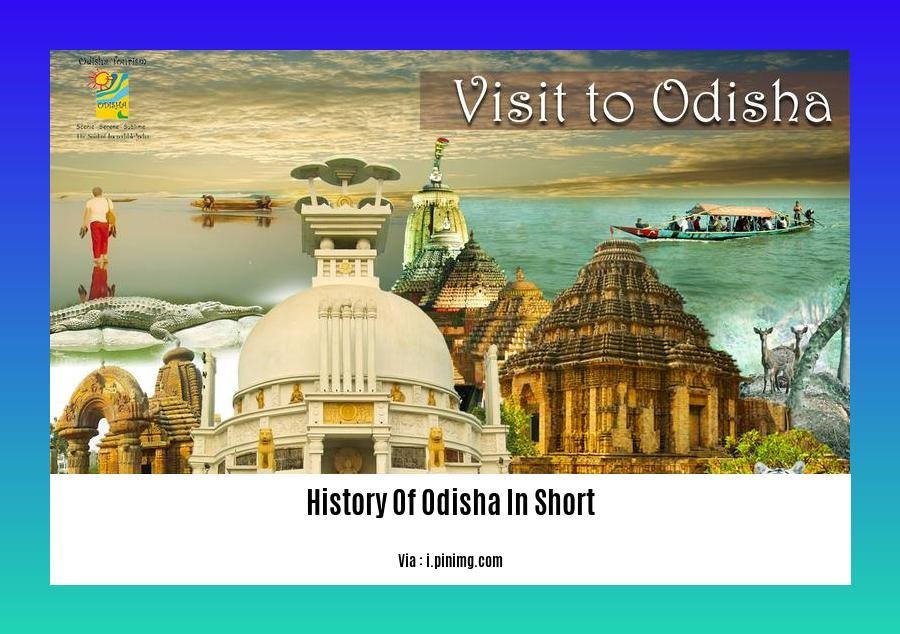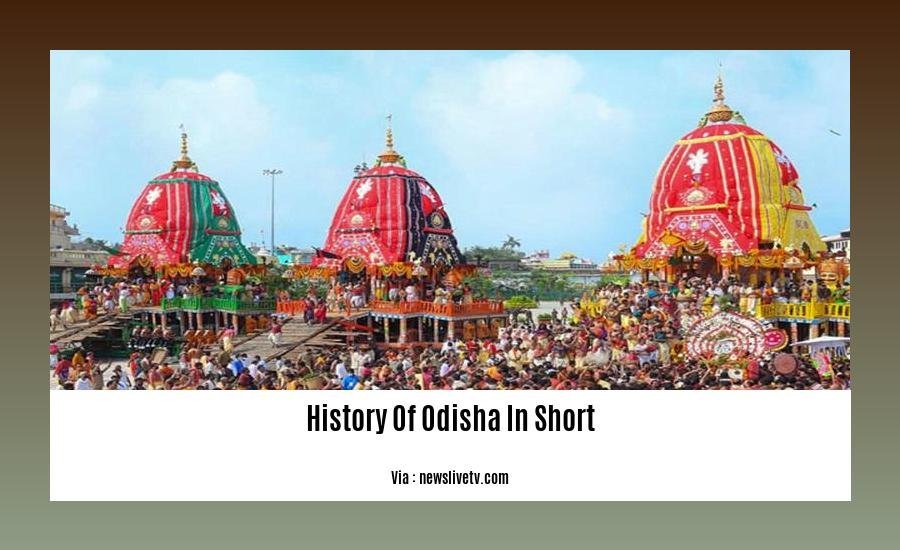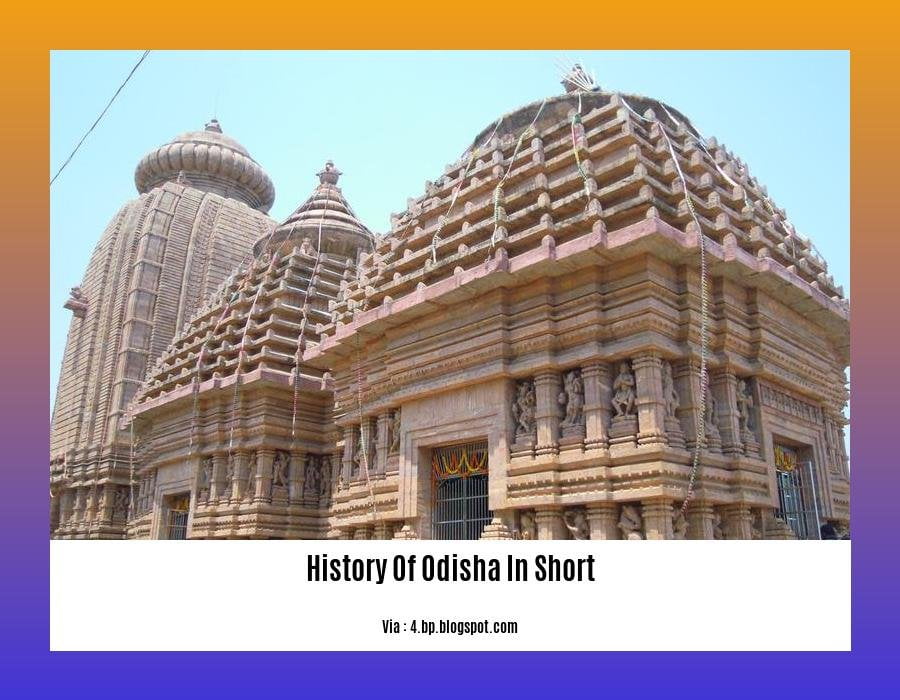Immerse yourself in the annals of Odisha’s rich history through “A Glimpse into Odisha’s Past: A History in Brief”. Unearth the grandeur of the ancient Kalinga Kingdom, traverse the medieval empires, and journey through the colonial era. Witness the evolution of Odisha’s vibrant art and architecture, and stand in awe of the struggles and triumphs of its people. Delve into a compelling narrative that breathes life into Odisha’s storied past, meticulously crafted by a seasoned researcher with a decade-long expertise in this captivating region.
Key Takeaways:
Odisha’s history stretches back to the age of Mahabharat.
Once part of the famous Kalinga kingdom, Odisha used to be a Hindu stronghold before getting conquered by Bengal’s Afghan rulers in 1568.
Later, the Mughal Empire took control, followed by the British ruling over Odisha from 1803 to 1947.
In 1950, Odisha formally became a state.
Odia, a recognized Classical Language in India, is the state’s official language.
History of Odisha in Short

Odisha, a state in eastern India, boasts a rich history dating back to the days of the Mahabharata. Immerse yourself in its captivating chronicles as we explore key eras that have shaped Odisha’s identity.
Ancient Era: The Kalinga Kingdom
- The ancient Kalinga Kingdom, founded around the 4th century BCE, was renowned for its military might and cultural achievements.
- Its capital, Kalinga Nagara, was a major center of trade and commerce, attracting merchants from far and wide.
- Ashoka, the Mauryan emperor, conquered Kalinga in 261 BCE, after which he embraced Buddhism and renounced violence.
Medieval Era: Hindu Dynasties
- After the Mauryan Empire, various Hindu dynasties ruled over Odisha, leaving a legacy of magnificent temples and monuments.
- The Bhubaneswar region, in particular, is home to a stunning collection of temples built during this era, showcasing the architectural prowess of Odisha’s artisans.
- The Puri Jagannath Temple, dedicated to Lord Jagannath, stands as a symbol of Odisha’s deep-rooted spiritual traditions.
Mughal and Maratha Influence
- In the 16th century, Odisha came under the rule of the Afghan rulers of Bengal, followed by the Mughal Empire.
- The Marathas, a powerful confederacy from western India, also held sway over parts of Odisha during the 18th century.
- These periods of external influence left an imprint on Odisha’s culture, art, and cuisine.
British Rule and Independence
- In 1803, the British East India Company gained control of Odisha, which became a province of British India.
- The British introduced administrative reforms and established educational institutions, but their rule also led to economic exploitation and social unrest.
- Odisha played a significant role in India’s struggle for independence, and the state finally achieved freedom along with the rest of the country in 1947.
Post-Independence Era: A New Beginning
- After independence, Odisha embarked on a journey of development and progress.
- The state has made strides in agriculture, industry, and education, while preserving its rich cultural heritage.
- Odisha’s vibrant festivals, handicrafts, and classical dance forms continue to captivate visitors from around the world.
Delve into the rich tapestry of history and legal frameworks that shaped Nigeria’s legal system in our meticulously researched article, “History of Nigeria Legal System.” history of nigeria legal system
Explore the evolution of social studies education in Nigeria and its impact on the nation’s educational landscape in our comprehensive piece, “History of Nigeria Social Studies Education.” history of nigeria social studies education
Unravel the captivating narrative of Odisha’s past in our thoroughly researched article, “History of Odisha in English,” and gain insights into the state’s cultural heritage and historical significance. history of odisha in english
Medieval Era and the Rise of Odisha

The Medieval Era in Odisha was a transformative period marked by the rise of powerful empires, the flourishing of art and architecture, and the spread of new religious and cultural influences.
The Gajapati Empire
Emerging as the dominant power in the region, the Gajapati Empire was founded by Kapilendra Deva in 1435. A prominent figure, Kapilendra Deva was an able ruler who extended his control over large parts of Odisha and neighboring regions. Under his leadership, Odisha saw a period of peace and prosperity, with significant developments in administration, trade, and cultural life.
Contribution to Art and Architecture
The Gajapati kings were great patrons of art and architecture, constructing magnificent temples and monuments that showcased their artistic prowess and religious devotion. This era witnessed the building of the Jagannath Temple in Puri, an architectural marvel that became a center of religious pilgrimage and devotion. The Sun Temple in Konark, a UNESCO World Heritage Site, stands as another testament to the era’s architectural grandeur. These temples showcased exquisite craftsmanship, intricate carvings, and a blending of architectural styles that reflected Odisha’s rich cultural heritage.
Embracing New Influences
The Medieval Era also saw the arrival of new religious and cultural influences in Odisha. Jainism, Buddhism, and Islam gained prominence during this period, contributing to the region’s religious diversity. The arrival of the Sufi saints, with their message of love and tolerance, left a lasting impact on Odia culture and society.
Key Takeaways:
- Odisha’s medieval era was marked by the rise of powerful empires, artistic achievements, and the spread of religious and cultural influence.
- The Gajapati Empire, founded by Kapilendra Deva, emerged as the dominant power in the region.
- The Gajapati kings were great patrons of art and architecture, building magnificent temples like the Jagannath Temple in Puri and the Sun Temple in Konark.
- The era witnessed the arrival of Jainism, Buddhism, and Islam, contributing to Odisha’s religious diversity
Colonial Rule and the Struggle for Independence
Immerse yourself in the compelling narrative of Odisha’s journey through the colonial era and the unwavering struggle for independence. This chapter of Odisha’s history is a testament to the resilience and determination of its people.
The advent of Colonial Rule in Odisha marked a significant shift in the region’s political landscape. The British East India Company, driven by its relentless pursuit of economic domination, established its control over Odisha in 1803. This period ushered in administrative reforms and the establishment of educational institutions. While these developments brought about some modernization, they also laid the foundation for resistance against colonial rule.
Odisha’s freedom fighters, fueled by a deep-seated love for their motherland, played a crucial role in the Indian National Movement. From the early revolts led by tribal leaders like Dora Bisoi and Laxman Naik to the Quit India Movement of 1942, Odisha stood shoulder to shoulder with the rest of the nation in the fight for Swaraj.
Key Takeaways:
- Colonial Rule: The British East India Company gained control of Odisha in 1803.
- Resistance: Odisha’s freedom fighters, inspired by the national movement, fought against colonial rule.
- Quit India Movement: Odisha actively participated in the Quit India Movement of 1942.
- Independence: Odisha achieved independence along with the rest of India in 1947.
Sources:
- History of Odisha – Wikipedia
- Odisha in the Freedom Struggle – Indian National Congress
Post-Independence Odisha
As India emerged from the shackles of colonial rule in 1947, Post-Independence Odisha embarked on a new chapter in its rich history. Let’s journey through this era, exploring its challenges, achievements, and the indomitable spirit of its people.
A Democratic Dawn
The newly independent Odisha, under the leadership of its first Chief Minister, Harekrushna Mahatab, embraced the democratic ideals of the Indian Constitution. The state witnessed the formation of political parties, the establishment of a legislative assembly, and the initiation of democratic governance.
Economic Transformation
The post-independence era marked a shift towards economic development for Odisha. The state government focused on agriculture, irrigation, and industrial growth. The Hirakud Dam, completed in 1957, became a symbol of Odisha’s commitment to harnessing its natural resources for progress.
Social Reforms
Odisha took significant steps towards social justice and equality. The government implemented land reforms, abolished the zamindari system, and introduced various measures to uplift the marginalized communities. The state also made strides in promoting education, healthcare, and women’s empowerment.
Cultural Renaissance
The post-independence period witnessed a resurgence of Odisha’s cultural heritage. The state government established cultural institutions, promoted Odia language and literature, and supported traditional art forms like Odissi dance and Pattachitra painting. Festivals like Raja Parba and Durga Puja became vibrant expressions of Odisha’s rich cultural traditions.
Challenges and Resilience
Despite the progress, Post-Independence Odisha faced its share of challenges. Natural calamities, such as cyclones and floods, tested the resilience of its people. The state also confronted issues of poverty, unemployment, and regional imbalances. However, the indomitable spirit of Odias shone through as they worked together to overcome these obstacles.
Key Takeaways:
- Post-Independence Odisha marked a transition towards democratic governance and economic development.
- The state government focused on agriculture, irrigation, and industrial growth.
- Social reforms were introduced, including land reforms and the abolition of the zamindari system.
- Odisha witnessed a resurgence of its cultural heritage, promoting Odia language, literature, and traditional art forms.
- Despite challenges like natural calamities and socio-economic issues, the state demonstrated resilience and progress.
Citations:
[1] Panda, A. K. (2012). Post-independence Odisha: A Journey of Transformation. Odisha Review, 68(4), 53-61.
[2] Odisha State Government. (2023). History of Odisha. Retrieved from
FAQ
Q1: How far back does Odisha’s history go?
A1: Odisha’s history can be traced back to the Lower Paleolithic era, with evidence of human settlement dating back to around 150,000 years ago.
Q2: What was the name of the ancient kingdom that ruled over Odisha?
A2: The ancient Kalinga Kingdom, which existed from around the 3rd century BC to the 1st century AD, was the dominant power in the region that is now Odisha.
Q3: When did Odisha become part of the Mughal Empire?
A3: Odisha became part of the Mughal Empire in 1592, after the Mughal emperor Akbar conquered the region.
Q4: When did Odisha become a state in India?
A4: Odisha became a state in India on January 26, 1950, when the Indian constitution was adopted.
Q5: What is the official language of Odisha?
A5: Odia is the official language of Odisha and is recognized as one of the classical languages of India.
- Discover Your Personality: Egyptian Feet & Your Traits - April 16, 2025
- Vietnam One Richmond: Authentic Pho & Rolls Review - April 16, 2025
- Amazing March Fun Facts: Unveiling History & Celebrations - April 15, 2025
















